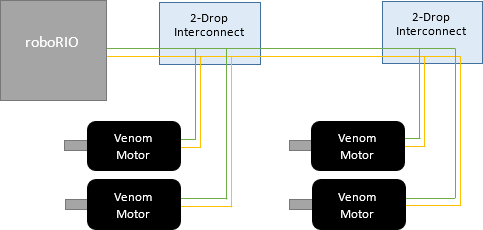Product Categories
- Arduino Shields
- Breakout Boards
- CAN (Controller Area Network)
- Connectors and Interconnect
- Drivers, DACs & Outputs
- FIRST Robotics Competition
- CAN Interconnect
- Motors
- Power Distribution
- Sensors
- Telescoping Arms
- Formula SAE
- Hardware
- Interface and Logging
- Power Supplies and Distribution
- Qwiic Connect System
- R3aktor Data Acquisition
- Sensors
- Software
- Switches, Encoders, & Buttons
- Temperature Measurement
- Wire
- Discontinued
Tech Article Categories
Home > Product Categories > FIRST Robotics Competition
Products - FIRST Robotics Competition
Battery state at your fingertips
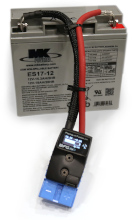 Your robot represents many thousands of dollars and hundreds of hours of effort. Don't let a dead, low-preforming, or weak battery cut even a single match short.
Ensure your robot preforms at its best, every time, with the ROB-70001 BFG!
Your robot represents many thousands of dollars and hundreds of hours of effort. Don't let a dead, low-preforming, or weak battery cut even a single match short.
Ensure your robot preforms at its best, every time, with the ROB-70001 BFG!
The BFG is a precision sensor, integrated into a SB120 battery cable assembly, that monitors battery current and voltage to identify discharge rate, current spikes, voltage dips, depth of discharge, and more. These measurements are preformed 100 times a second 24 hours a day to provide you with a full picture of your battery's overall health and state of charge. Since the BFG is always connected it knows how hard each battery was used, how it was cared for, and compiles that data into a comprehensive health metric you can instantly view from the onboard OLED display.
Look for the C/Java/LabView API late-November.
Measure distance with laser precision
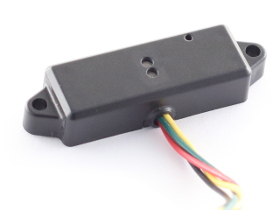 The SEN-36005 is a highly integrated time-of-flight ranging/distance sensor. It utilizes an invisible class 1 laser to
measure absolute distance regardless of the target color or reflectance. The CAN interface allows the sensor to connect
seamlessly to a roboRIO or other CAN devices.
The SEN-36005 is a highly integrated time-of-flight ranging/distance sensor. It utilizes an invisible class 1 laser to
measure absolute distance regardless of the target color or reflectance. The CAN interface allows the sensor to connect
seamlessly to a roboRIO or other CAN devices.
The compact size and simplicity of the SEN-36005 make it an excellent choice to measure robot actuator positions as well as to detect and avoid obstacles in the field.
Power Distribution
Our new power distribution products make robot wiring easier than ever! PWR-10001 and
PWR-10002 let you distribute power with the versatile XT30 connector. The small footprint is
mountable virtually anywhere on your robot. We have extensively tested these boards to ensure
they will support whatever current you can run through them as allowable by the rulebook.
For lower current applications, PWR-20001 is an excellent choice. Each of the 6 channels features a 500mA resettable PTC fuse, protecting your delicate sensors from current spikes. Its small form factor makes it easy to place in any convenient location.
CAN Distribution
New for the 2024-2025 FRC season are our Inline
and “Y” CAN splitters! Designed to be
seamlessly integrated directly into a spi-wrap branch, these boards turn your mess of wires into
streamlined cable management. We offer several different formats with one input and two to
three outputs. Each board also features insulation displacement connectors (IDCs). These are
so easy to use you don't even need to strip the wire after making a slice. Just insert the end into
the connector and you'll be good to go!
The two and four port drops are perfect for connecting CAN devices which are close together such as a pair of motors in a transmission housing. While daisy chain routing is best practice, it is acceptable to 'T' into a CAN bus as long as the length of the 'T' or the drops is less than 11 inches (approximation based on 1Mbit bit rate).
Example of a CAN Bus using short drops to tie left and right motor pairs onto the main CAN trunk:
For devices which are more than 11 inches apart, we recommend our 5-port daisy interconnect board.
Checkout our CANTerm 120 Ohm termination resistor for an easy way to add CAN termination to your network.
Telescoping Powered Arm
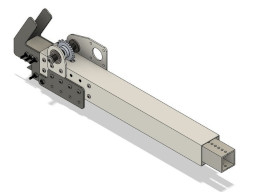 We’ve taken our original Telescoping Arm design and adapted it to better accommodate the 2024 FRC Game, CRESCENDO! The new design is built off the same tube-in-tube rack and pinion design as the original, but comes in a smaller form factor and adds several new components to support an efficient climb. ROB-17562 includes components to support both hooking the chain and for latching the arm once a successful climb has been achieved.
We’ve taken our original Telescoping Arm design and adapted it to better accommodate the 2024 FRC Game, CRESCENDO! The new design is built off the same tube-in-tube rack and pinion design as the original, but comes in a smaller form factor and adds several new components to support an efficient climb. ROB-17562 includes components to support both hooking the chain and for latching the arm once a successful climb has been achieved.
We include additional mounting plates, chain hooks, latch, and spring components in the box. Check out the video on our YouTube channel to see it in action! This arm takes the guesswork out of creating a precision telescopic manipulator by integrating inner and outer tubes, slider blocks, and an innovative gear tooth drive scheme.
SnakeEyes Robot Vision System
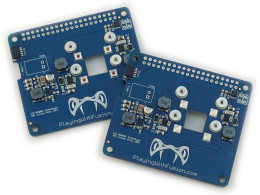 SnakeEyes enables cost-effective FRC vision targeting and lets you customize your vision application. You pick your ideal stack of Raspberry Pi version, camera, LED color, and even software application! Power to your Pi is provided via passive PoE, which powers an efficient, onboard 5V buck regulator, and 4x dimmable, high power LEDs brighten any arena. A Raspberry Pi Cam V2 mounting pattern lets you select between a standard or NOIR camera.
SnakeEyes enables cost-effective FRC vision targeting and lets you customize your vision application. You pick your ideal stack of Raspberry Pi version, camera, LED color, and even software application! Power to your Pi is provided via passive PoE, which powers an efficient, onboard 5V buck regulator, and 4x dimmable, high power LEDs brighten any arena. A Raspberry Pi Cam V2 mounting pattern lets you select between a standard or NOIR camera.
Take control of your vision program with SnakeEyes
Venom Smart motor
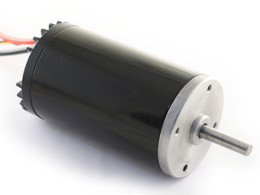 Introduced for the 2020 FRC season: Venom is a brushed DC motor
based on the original 2.5" CIM used by FIRST Robotics Competition
teams for the past 20 years. The traditional CIM is a "dumb" motor, requiring a suite of external controllers and sensors.
Venom integrates all of these functions into a single, compact package.
Introduced for the 2020 FRC season: Venom is a brushed DC motor
based on the original 2.5" CIM used by FIRST Robotics Competition
teams for the past 20 years. The traditional CIM is a "dumb" motor, requiring a suite of external controllers and sensors.
Venom integrates all of these functions into a single, compact package.
The motor controller and speed encoder are embedded into the rear motor end plate. There are no concerns about mechanical
compatibility between third party sensors. There are no calculations required to convert encoder counts into speed. All
motor parameters are presented in native engineering units (speed in RPM, voltage in Volts, etc.) through a convenient API
(C++, Java, and LabView)
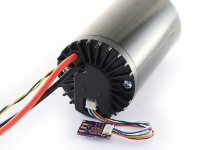
In addition to the "smart" upgrades, we've also made the CIM stronger. Front and rear bushings have been upgraded to ball bearings to reduce friction, increase efficiency and extend battery life. The wiring was upgraded from 14 ga external wiring for 12 ga high-strand.
An optional limit switch and analog input (LSA) breakout board may be connected to the rear of Venom. External limit switches are a great way to prevent robot damage by preventing motor rotation past end stops.
Sense Color and proximity
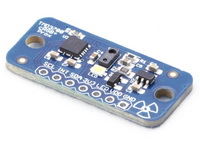 Add color vision to your robot using the SEN-36004.
This sensor integrates color, proximity, and ambient light intensity sensing into a single package. A white LED is also included
to allow color measurement of close or poorly illuminated objects. This sensor is not calibrated to measure absolute distance,
but it is sufficient to detect if an object is close or not.
Add color vision to your robot using the SEN-36004.
This sensor integrates color, proximity, and ambient light intensity sensing into a single package. A white LED is also included
to allow color measurement of close or poorly illuminated objects. This sensor is not calibrated to measure absolute distance,
but it is sufficient to detect if an object is close or not.
This sensor uses an I2C interface. Arduino source code is available now. We will provide roboRIO compatible C/Java/LabView libraries mid-January.
Power and CAN wiring
Route power using the same high-quality, silicone-coated wire used on our Venom motor. The 12ga wire features a 680 strand count, and is very flexible. Outside diameter (OD) is approximately 0.177 inch. Sold by the foot, min 3 feet. Orders less than 100 ft will ship as continuous lengths.
Twisted pair CAN wire is also available by the foot.

